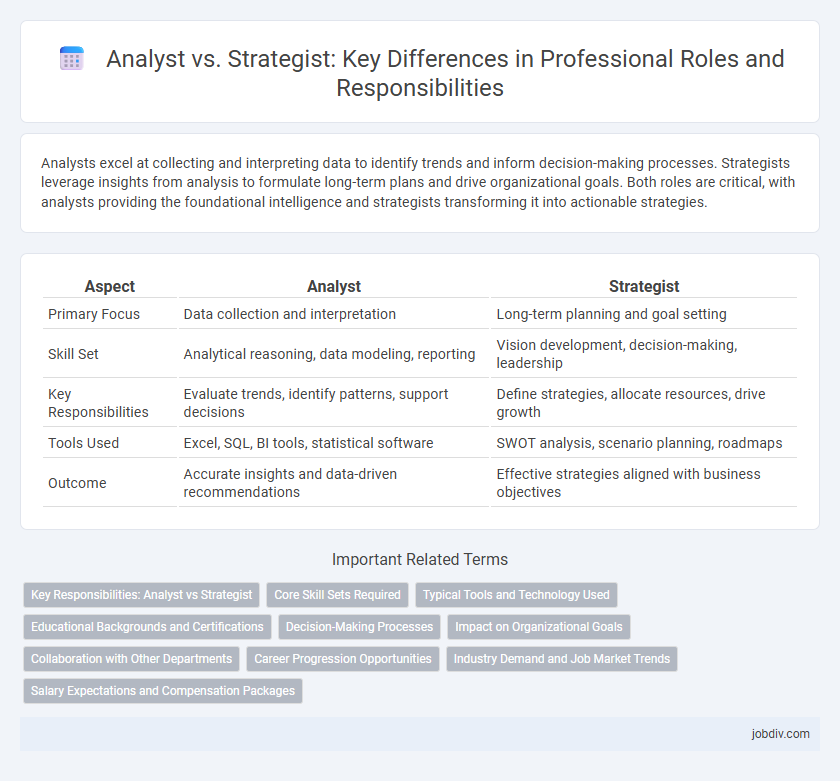Analysts excel at collecting and interpreting data to identify trends and inform decision-making processes. Strategists leverage insights from analysis to formulate long-term plans and drive organizational goals. Both roles are critical, with analysts providing the foundational intelligence and strategists transforming it into actionable strategies.
Table of Comparison
| Aspect | Analyst | Strategist |
|---|---|---|
| Primary Focus | Data collection and interpretation | Long-term planning and goal setting |
| Skill Set | Analytical reasoning, data modeling, reporting | Vision development, decision-making, leadership |
| Key Responsibilities | Evaluate trends, identify patterns, support decisions | Define strategies, allocate resources, drive growth |
| Tools Used | Excel, SQL, BI tools, statistical software | SWOT analysis, scenario planning, roadmaps |
| Outcome | Accurate insights and data-driven recommendations | Effective strategies aligned with business objectives |
Key Responsibilities: Analyst vs Strategist
Analysts focus on collecting, interpreting, and reporting data to identify trends and insights that support decision-making processes. Strategists develop long-term plans by synthesizing complex information, setting objectives, and aligning resources to achieve organizational goals. Analysts provide data-driven recommendations, while strategists prioritize vision-setting and execution oversight based on those insights.
Core Skill Sets Required
Analysts excel in data interpretation, statistical analysis, and detailed problem-solving, facilitating evidence-based decision-making through rigorous data evaluation. Strategists emphasize visionary thinking, long-term planning, and competitive insight to drive organizational growth and navigate market dynamics effectively. Both roles demand strong communication skills, but analysts prioritize quantitative accuracy while strategists focus on holistic business impact.
Typical Tools and Technology Used
Analysts typically utilize data visualization tools such as Tableau, Excel, and SQL databases to interpret quantitative data and generate actionable insights. Strategists often rely on frameworks like SWOT analysis, Balanced Scorecards, and project management software such as Microsoft Project or Asana to align business goals with long-term objectives. Both roles increasingly incorporate AI-powered analytics platforms and cloud-based collaboration tools to enhance decision-making processes.
Educational Backgrounds and Certifications
Analysts typically hold degrees in fields such as finance, economics, mathematics, or data science, often supplemented with certifications like CFA, CPA, or CBAP to enhance their data analysis and financial modeling skills. Strategists commonly pursue educational backgrounds in business administration, strategic management, or marketing, with certifications including PMP, Six Sigma, or Balanced Scorecard Professional, emphasizing leadership and long-term planning expertise. Both roles benefit from advanced degrees like MBAs, but their certifications and coursework reflect distinct focuses on quantitative analysis versus strategic decision-making.
Decision-Making Processes
Analysts excel at interpreting data to identify trends and support evidence-based decisions through detailed evaluation and risk assessment. Strategists prioritize long-term vision and alignment with organizational goals, focusing on scenario planning and adaptive frameworks to guide decision-making. Effective decision-making integrates analytical precision with strategic foresight to optimize outcomes in complex business environments.
Impact on Organizational Goals
Analysts drive organizational goals by leveraging data to identify trends and optimize operational efficiency, enabling informed decision-making. Strategists focus on long-term vision and competitive positioning, aligning resources to achieve sustainable growth and market leadership. Both roles complement each other by integrating detailed insights with forward-thinking plans to maximize overall business impact.
Collaboration with Other Departments
Analysts provide data-driven insights that enable strategists to make informed decisions, fostering seamless collaboration between departments such as marketing, finance, and operations. Strategists integrate these analytical findings to design actionable plans that align with organizational goals, ensuring cross-departmental synergy. Effective collaboration between analysts and strategists drives cohesive workflows, enhances communication, and improves overall business performance.
Career Progression Opportunities
Analysts typically begin their careers by mastering data interpretation and reporting, laying a strong foundation for decision-making roles. Strategists build on this foundation by leveraging insights to shape long-term business plans and drive organizational growth. Career progression from analyst to strategist often involves developing advanced skills in market analysis, competitive intelligence, and cross-functional leadership.
Industry Demand and Job Market Trends
Analysts and strategists both play critical roles in business decision-making, yet industry demand highlights a growing preference for strategists who can leverage data to drive long-term growth and innovation. Job market trends reveal higher demand for professionals with strategic expertise in digital transformation, competitive analysis, and market expansion. Analysts remain essential for in-depth data interpretation, but companies increasingly seek strategists to translate insights into actionable business strategies.
Salary Expectations and Compensation Packages
Analysts typically earn a median salary ranging from $60,000 to $85,000 annually, depending on industry and experience, while strategists command higher compensation, often between $90,000 and $130,000, reflecting their broader impact on organizational direction. Compensation packages for strategists usually include performance bonuses, stock options, and profit-sharing, whereas analysts receive more standardized benefits with potential for overtime pay. Understanding these salary expectations and compensation differences is crucial for professionals navigating career progression in business and finance sectors.
Analyst vs Strategist Infographic

 jobdiv.com
jobdiv.com